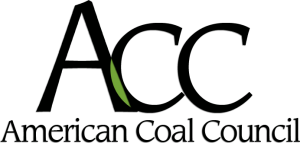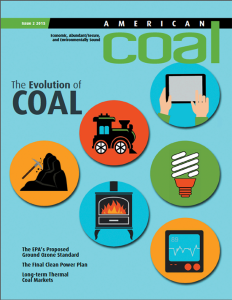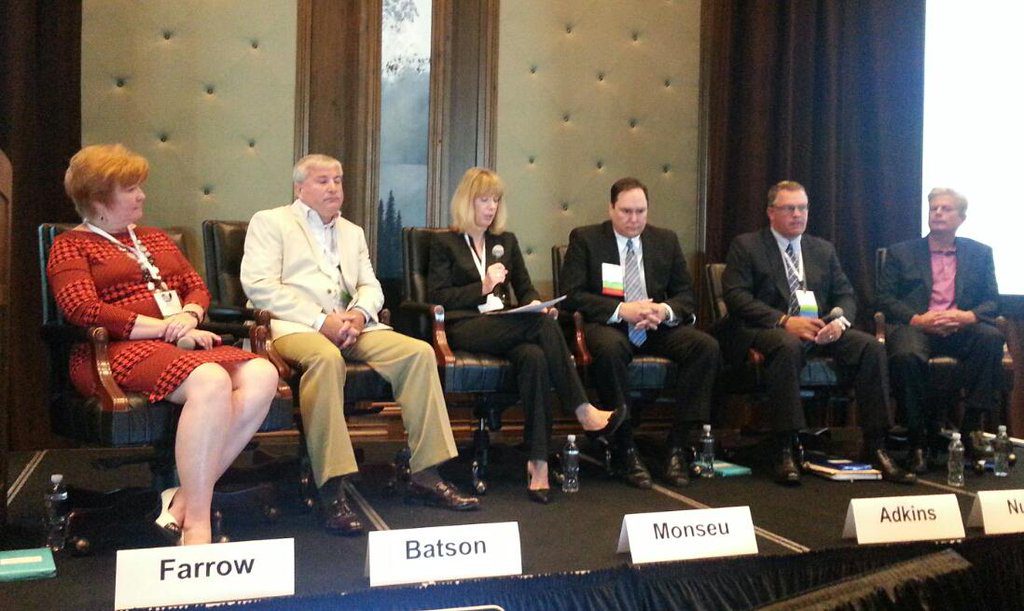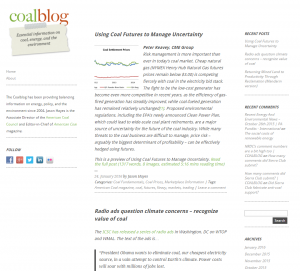The Joys of Mentoring, Mining Talent and Wearing Many Hats

For the past three years, Betsy Monseu, chief executive officer of the American Coal Council (ACC), has guided the ACC to impressive membership growth despite industry consolidation and rising regulatory challenges. The ACC serves 170 member companies across the entire coal industry.
![]()
Leadership style of @BetsyMonseu of @AmericanCoal is “hands-off” when possible & “hands-on” when needed.
Associations have many electronic tools, but nothing replaces a conversation’s info, emotion and conviction.
Emerging leader programs should serve young professionals & mid-career professionals new to your industry.
An association career lets you wear many hats and have your hand in many interesting pots.
Association Adviser: Betsy, tell us a little about the American Coal Council.
 Betsy Monseu: For 34 years, the American Coal Council has been providing educational programs, market intelligence, advocacy support and peer-to-peer networking forums for more than 170 member companies large and small. ACC represents the collective interests of the American coal industry in advocating for coal as an economic, abundant and environmentally sound fuel source.
Betsy Monseu: For 34 years, the American Coal Council has been providing educational programs, market intelligence, advocacy support and peer-to-peer networking forums for more than 170 member companies large and small. ACC represents the collective interests of the American coal industry in advocating for coal as an economic, abundant and environmentally sound fuel source.
AA: Is there such a thing as a typical ACC member?
BM: There’s really no such thing as a typical member. However, we all have strong convictions around our belief that coal is a critical energy source in the U.S. and globally.
AA: Have you been able to grow membership during this fickle, slow-growth economy?
BM: Yes. We added 22 new member companies in the past year even though our industry is facing some consolidation and downsizing. We advocate strongly for coal and for the companies related to various segments of the industry. We continue to get inquiries from companies that haven’t been ACC members before. That’s very healthy because it brings in fresh perspectives and adds to the complementary nature of the companies that are already ACC members.
AA: Any idea what’s driven your membership spike?

BM: Folks call in and say they heard about us from one of our member companies. Some say they received our magazine American Coal, which goes to non-members as well as members. After looking at the membership page in our magazine, they realize many of their customers are members of our council. That gets them thinking that they should be members as well. Also, we’re actively reaching out to companies whose businesses that we think would benefit from ACC membership and participation in our council. We have so many electronic tools at our disposal, but nothing really takes the place of one-on-one conversations to truly convey information, emotion and conviction.
AA: How about your other membership recruitment channels?
BM: It’s a blend of old and new approaches. [Associate Director] Jason Hayes and I speak at many industry events and have numerous opportunities for contact and conversation. It can also be through our social media outlets—we have the Coalblog plus Facebook, LinkedIn and especially Twitter.
AA: What are some of the biggest misconception people have about coal?
BM: Many people don’t realize that 40 percent of world’s electrical needs are met through coal. The growth of coal globally exceeds the growth of oil and natural gas combined. That’s pretty stunning. The U.S. is fortunate to possess 30 percent of world’s total coal reserves. As far as extracting [those reserves], technology doesn’t stand still. There continue to be advances and improvements in extracting, shipping and consuming coal, and reclaiming the land after mining is completed. I continue to be surprised by the range of inquiries, questions and requests for information about coal that we get from such a variety of people, companies and organizations.
AA: You worked for several energy corporations before joining ACC. Have those experiences been transferable to the not-for-profit world?
BM: I certainly learned a lot during my time in the corporate utility, railroad and coal mining sectors. Running ACC isn’t that much different. There’s really no magic to it. It’s about effective cost management and fiscal stewardship. It’s about best practices and the optimal management of all of your economic and staff resources. Of course, when you have only two other full-time employees and one part-time employee, everyone has to wear A LOT of hats here like they do at many associations. Actually, that’s one of the things I’ve enjoyed since coming over to the association side—the great variety of things that I’m involved in. I get to have my hand in so many different pots. Corporate entities can be much more siloed.
AA: How would you describe your leadership style?
BM: I believe in leadership by example. I’m generally very direct. I try to be responsive to my staff, board, members and to others who are engaged in our community. From a management standpoint, I’m “hands-off” when I can be and “hands-on” when I need to be. Ultimately I’m accountable for the association and its effectiveness. It’s very gratifying when people I used to work with tell me: “It took me some time to understand some of the decisions you made, but having now worked at other places for other people, I want to thank you.” There’s nothing more gratifying than teaching and mentoring people. It’s important for those in management to facilitate relationships and allow people to grow. But, it’s also important for those being mentored to make the relationship mutually beneficial.
AA: What else do you like about working in the association world?
BM: It’s the opportunity to continue my participation and career in the coal industry after coming from the corporate side. I enjoy serving my colleagues in the industry and I enjoy collaborative efforts on behalf of the industry.
AA: Do have any special strategies for connecting with Millennial staffers and young members of the profession?
BM: The Tomorrow’s Leadership Council is certainly a priority for us and it’s been a very popular program. It’s been a good way to connect not only with Millennials, but with others who may have come into coal later their careers. It’s a great way to get networked with a peer group and to gain exposure to senior leaders in the industry. I wish I had a program like this in the early years of my own career.
AA: While with Alpha Natural Resources, you coordinated industry positions with several associations, council and interested groups. What was your motivation for doing so?
BM: I participated in a number of different arenas, each with a number of different focuses or objectives. Ultimately I think it’s important to be a joiner. It’s important for people to come together. The whole is greater than the sum of its parts and that’s what synergy is. We can have more of an impact working together than we can by working independently.
AA: What are the biggest challenges faced by ACC members and how is ACC helping them?
BM: Two things: regulatory and marketplace challenges. Like other successful trade organizations, ACC has morphed and changed with the times. We have seen an increasingly onerous regulatory environment and energy policies that would diminish the use of coal and coal technology advancements. So, we have been increasingly active in responding to those regulations by putting our council’s position in writing and in formalized comments about the rulemaking that is occurring. It’s also about responding to marketplace challenges. The biggest end user for coal is the electricity sector. And growth in that sector is pretty tepid. With the abundance of cheap energy, particularly natural gas, we’re increasingly competing with natural gas as a fuel source input for making electricity. We are up to the challenge of being competitive in our market. But when regulations diminish our market or shut down coal fuel plants, that’s another matter.
AA: To what extent is the coal industry affected by the economy in general and declining oil prices in particular?
BM: When oil prices decline, the cost of running heavy mining equipment goes down, which is generally good for our members. We’re tied to the overall economy in terms of industrial production and in terms of how much demand there is for fuel, cement and other industrial products. A more robust economy will spark more demand for electricity usage which increases demand for coal.
AA: Association Adviser’s focus this month has been on professional education and career development. Can you tell us about ACC’s initiatives in these areas?

BM: Our onsite conferences have been very popular. We hold three large events per year, including the Spring Coal Forum coming up in March. We have our monthly webcast series (Coal Q&A), which is free to members and available at a nominal cost to non-members. We try to provide both onsite and virtual learning opportunities, supplemented by ongoing programs such as Tomorrow’s Leadership, which allows participants to attend two of our live events as part of the package. They receive specially designed leadership seminars as part of their attendance at those live conferences. They also have the opportunity to participate in networking dinners that we arrange with speakers and with other senior leaders in the industry. They also work on year-long group projects with their peers, so it’s a nice combination of networking and face-to-face and virtual learning. At the end of the year, they share the results of their project in the Coal Q&A webcasts.
AA: What are ACC’s most important member communication vehicles?

BM: We’re engaged in all major social media platforms. I would say our Twitter platform has grown the most over the past two years to over 2,700 followers. It’s a quick way for folks to keep up with what’s going on. We have American Coal, our semi-annual member magazine, in print and online form as well as a related bimonthly e-newsletter, plus Coalblog and a monthly member newsletter. When you count the pass-along factor, our magazine is reaching over 20,000 people. We started live-tweeting from conferences several years ago. That has been very popular with folks at the event as well as with folks who couldn’t attend in person.
AA: What’s keeping you up at night?
BM: Only things related to our regulatory environment and the fact that our national energy policy has been driven by too much federal regulation. It’s disappointing that the raft of new environmental regulations has been affecting the production and consumption of coal. In reality coal doesn’t have much [negative] impact on the environment, but if production goes down it will have a big impact on the cost of electricity for Americans. Will my kids be able to pay their electric bills when they go out into the world and make their way? That’s what keeps me up.

